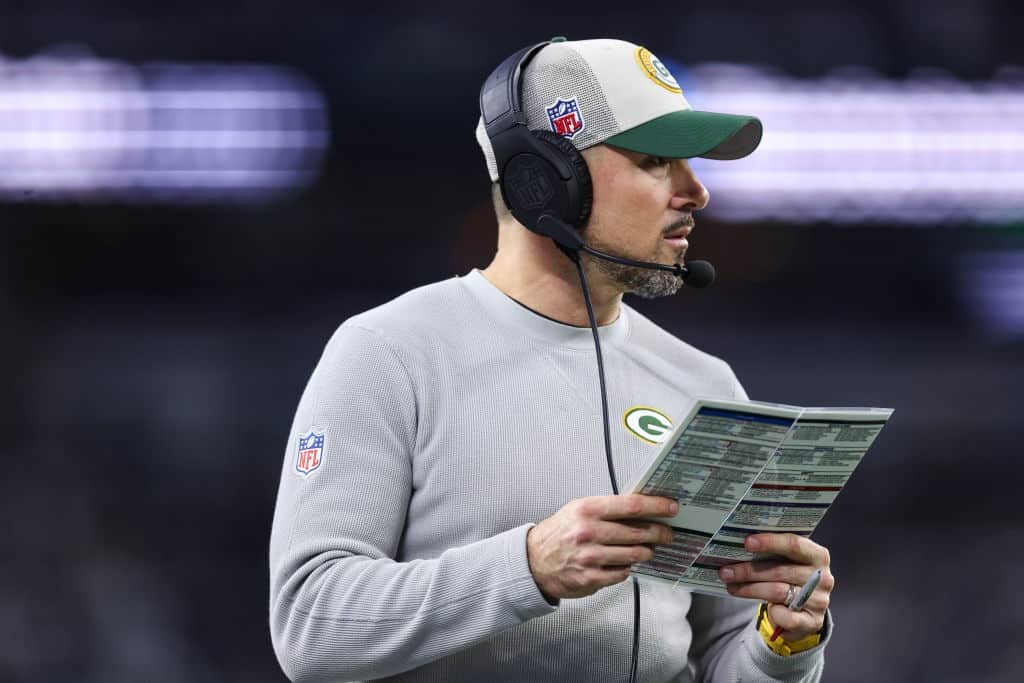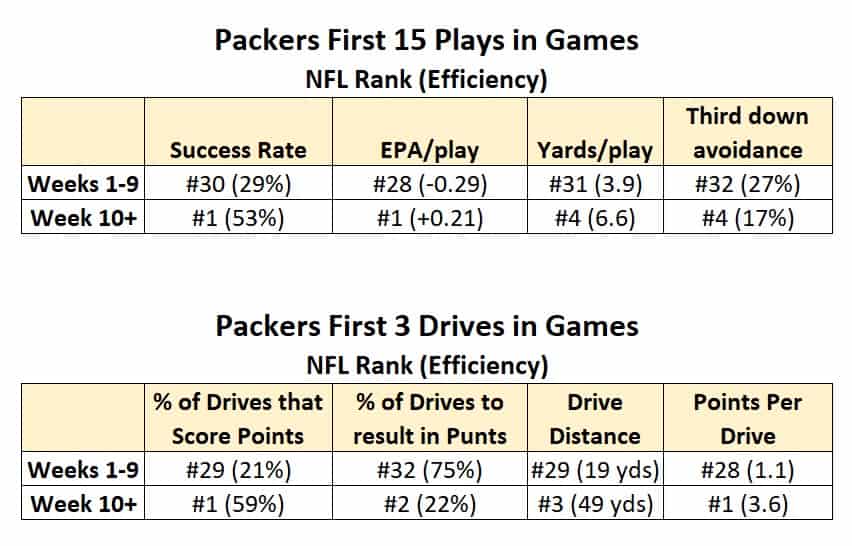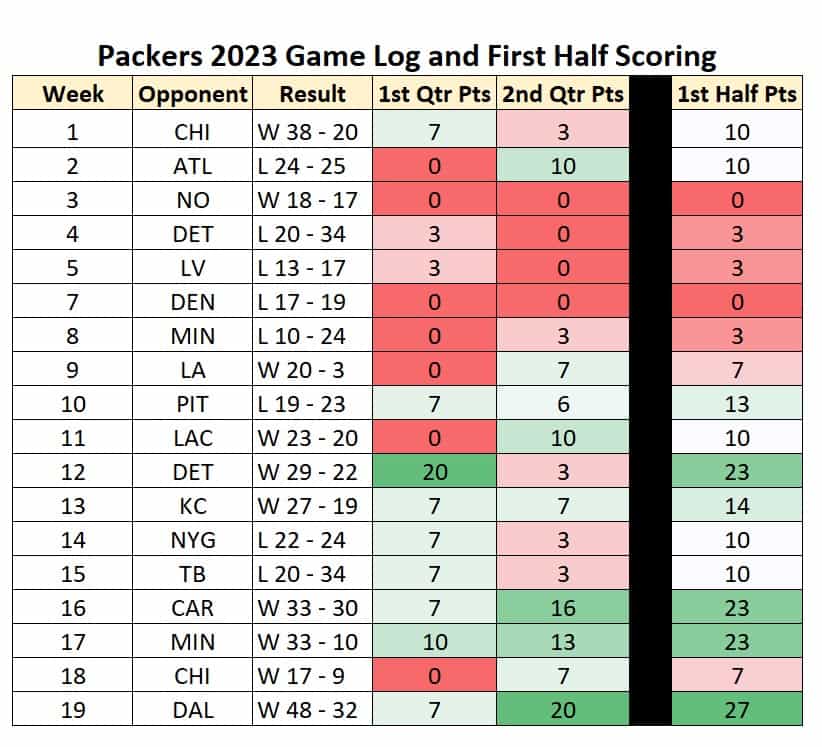It was late October in the first year of Jordan Love starting for Green Bay, and their season was slipping through their fingers.
The Packers sat at 2-5 after dropping four straight games and desperately needed to improve their offense.
If they didn’t, the season would soon spiral out of control, the rumors would begin, questioning if Love was the right QB to succeed Aaron Rodgers for the next 15+ years.
Looking back on the first seven weeks of the season, I decided to try to understand what was failing the Packers so much.
Why were they losing so many games, and why was the offense completely unproductive?
After all, the Packers went through a stretch where the offense scored three or fewer points in the first half of games for five consecutive weeks.
After researching, I realized several issues with the Packers offense.
But these weren’t issues with Love. Or the offensive line. Or the receivers.
It wasn’t an issue with their personnel.
It was an issue with their philosophy, their strategy, and their goals offensively.
So, I summarized my findings in an article: The Packers Have a Coaching Problem
Though there were major failings with the offense, I believed that identifying them was good news for the 2-5 Packers.
Because if they simply changed their philosophy, strategy, and goals offensively, they COULD turn their season around.
They could get back on track.
Don't Miss Out on Our Historic Season
2023 has been Warren Sharp's most profitable season betting on the NFL in the last decade.
A $100 bettor is up $8,148 following Warren's recommendation this NFL season.
We have been even stronger late in the season, going 62-29 (68%) on elevated plays over the last two months.
And the fun is not over. Our weekly postseason packages are live, and we are offering a great deal.
Use code PLAYOFFS to get 50% off either the weekly or full postseason package.
» Learn more about this offer!
However, the coaches would need to take the situation seriously and be willing to change their approach.
Not only is that sometimes difficult for coaches to do, as they need to admit they were making errors, but it’s also hard to pull off a change midseason. There isn’t a lot of time for teams to identify these things in the flow of the year and change philosophy quickly enough to save their season.
Matt LaFleur and his staff executed changes quickly, quietly, and effectively.
It was a masterful job, and the final results have them in the Divisional Round of the 2023 playoffs after starting 2-5.
They finished the season 7-3 before going on the road to absolutely eviscerate the No. 2 NFC seed Dallas Cowboys.
What were their issues over the first half of the year?
I identified several in the study, but the biggest ones were:
- Lack of explosiveness
- Poor scripting
- Inability to build a quick lead
My conclusion of the article:
“Instead of complicating things in their first half play calling, the Packers need to get back to the basics of what works in the NFL and for them:
Come out the gates aiming to produce one explosive gain on each drive while calling plays that attack opponent weaknesses.
Forget slow-playing things or setting things up for late in the game. Simply try to score points on each drive and build a lead.
Let your opponent be the ones to dig themselves out of a second-half hole instead of you.”
Let’s go through each of these, as they dovetail into one another, and look at where they were and where they are now.
Lack of Explosiveness
I looked at the Packers' production offensively when they had even one explosive play on a drive.
Without an explosive play, the Packers were below average in virtually every key statistical drive category, including:
- points per drive
- scores per drive
- red zone trip rate
- punt rate
But when they had even one explosive play on a drive, the Packers shifted to:
- 4.53 points per drive (#5), up from 0.98 without an explosive play
- 80% of drives score points (#7), up from 18% without an explosive play
- 67% of drives reach the red zone (#6), up from 16% without an explosive play
- 0% of drives result in a punt (#1), down from 51% without an explosive play
If the Packers were so elite when producing explosive plays, especially compared to when they don’t get one, how did they rank to start the season?
Weeks 1-9:
- 20.9% of first half drives featured an explosive play (#32)
- 35.6% of all drives featured an explosive play (#22)
Though they were trying to throw deep, with Love averaging the deepest target depth in the NFL, it wasn’t working. They needed to find a different way to prioritize getting explosive gains which would be more consistent and produce results.
And they clearly did.
Week 10 onward:
- 59.2% of first half drives feature an explosive play (#3)
- 54.6% of all drives feature an explosive play (#2)
They shifted from #32 in explosive drive rate in the first half of games to #3 since Week 10.
From essentially 20% to 60%, an absolutely massive improvement.
These chunk gains put them in scoring position faster, erased negative plays quicker, and resulted in fewer plays per drive down the field.
Poor Scripting
The Packers' first 15 plays were terrible to start the season.
The lack of efficiency from their offense not only wasn’t scoring points (#29 in score rate), but they also weren’t helping their defense at all, ranking #29 in drive distance.
They weren’t just not scoring, they were not even flipping the field to allow their defense the benefit of good starting field position.
But LaFleur quickly made massive improvements in how he would begin games and script plays.
The results were shocking, whether you look at the first 15 plays or the first three drives:
Credit to LaFleur and his staff, because this game planning is elite.
Inability to build a quick lead
At the time of my midseason study, on the importance of building early leads, I wrote:
“If anyone should know the importance of building a lead, it’s Matt LaFleur.
Since he took over in Green Bay in 2019, the Packers are 34-6 (86%) when leading at the half.
When trailing at the half?
The Packers are 11-18 (38%).”
The Packers needed to play from ahead. They’ve been great when doing so. It worked for LaFleur, it worked for Aaron Rodgers, and it has worked for Love.
But because of the lack of explosives in the first half (#32) and the terrible scripting early in games (#32 in third down avoidance, #32 in punt rate, #28 in points/drive), the Packers offense was not putting up points.
The Packers needed to be more explosive early in games and develop a better game plan coupled with a philosophy that emphasized scoring early and building leads.
The results speak for themselves as it relates to early scoring, in both the first quarter and the first half overall.
They’ve recently cranked things to another level, by taking the ball when they win the toss.




















